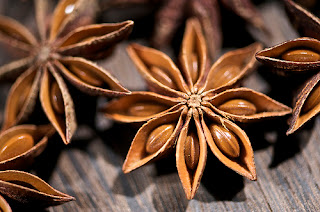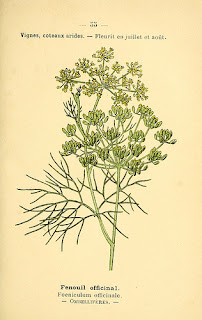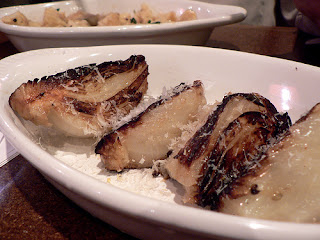from
Behind the French Menu
by
Bryan G. Newman
behindthefrenchmenu@gmail.com
Anise
www.flickr.com/photos/biodivlibrary/29056761323/
Anise is also called aniseed, green anise,
and Roman aniseed.
Aniseed is the seed-like fruit of anise.
Anise is the spice behind so many foods that have a licorice (liquorice in British English) taste. You may be buying licorice sweets (candies), but in 98% of the cases, it is anise that is providing the taste.
The scent and taste of licorice are loved in France but the taste of the spice called réglisse, the real licorice, is considered to be too intense for most recipes. Anise heads the list of licorice tasting herbs that chefs work with. Along with Anise, recipes will use aneth, dill; fenouil, fennel; and anis étoile or badiane, star anise, and with so many choices chefs may choose the exact level of the licorice taste they desire. Anise and the others are different plants, but they are all sweet and aromatic.
Anise is the spice behind nearly all licorice accented drinks
Licorice accented drinks in France includes Absinthe, Anisette, Casanis, Pastis, Pastis 51, Pernod, Ricard, and many many more. Outside France anise, flavored drinks include the Greek Ouzo, Italian Sambuca, as well as Lebanese and Israeli Arak. All these liquors are clear, but with the addition of water becomes cloudy, some with a light green shade. (The green color gave the original Absinthe, before it was banned, its nickname La Fée Verte, the Green Fairy).
Pastis Janot from Provence.
www.flickr.com/photos/farehamwine/24145410493/
Anise is very important in French homeopathic medicine and also flavors and scents soaps, toothpaste, and mouthwashes.
Anise on French Menus:
Brochette de Queues de Gambas et Saints Jacques Flambées a l'Anis – A skewer of jumbo shrimp (tails) and king scallop meat flambéed in anise.
Huîtres (6 Pièces) En Escabèche Avec Oignons Caramélisés Et Anis - Oysters (6 pieces) prepared as an escabeche with caramelized onions and flavored with anise.
Banshee Balls (contains anise).
www.flickr.com/photos/ministryofstories/6151945303/
Médaillon de Queue de Lotte Grillée, Crème d’Anis Vert, Garnitures – A round cut of grilled monkfish tail served with a cream of anise sauce and vegetables.
Pot-au-Feu de Bœuf Avec des Carottes, des Pommes De Terre, Anis, Ail, Gingembre et Sauce Soja –A beef stew prepared with carrots, potatoes, anise, garlic, ginger and soy sauce. A Pot-au-feu also called a Pot Bouilli is at its simplest a traditional beef stew. A traditional pot-au-feu is usually accompanied by fresh country bread, mustard, cornichons and those tasty, small, French pickled white onions. It pays to ask the waiter how the stew is served as the traditional accompaniments may make this dish a meal on its own.
The anise flower
flickr.com/photos/pussreboots/15211786099/
Anise has Mediterranean origins probably in Crete or Egypt; it would have certainly been brought to France by either the Greeks or the Romans who occupied France as they both had many recipes that include anise. If anise arrived earlier, then it would have come with those seaborne Mediterranean wholesalers the Phoenicians. The Phoenicians would have brought it from Egypt where Anise was in use over 3,000 years ago.
There have been many changes in the French kitchen as tastes have changed and French chefs have brought anis étoile, star anise, from China into French recipes and the Chinese now add anise to their Five Spice Powder when they want a mellow accent.
Anis de Flavigny
Anis de Flavigny is a traditional French sweet, candy, called the Anis de Flavigny. It comes from Flavigny-sur-Ozerain in Burgundy in the region of Bourgogne - Franche Comte. Today these traditional sweets are made in other flavors, but they are still called anis.
These French candy, sweet, producers have an English language website:
(Catalan - anís, batafaluga or matafaluga), (Dutch - anijsplant), (German - anise), (Italian - anice anche, anice verde), (Spanish - anís, anís verde).
Connected Posts:
Behind the French Menu’s links include hundreds of words, names, and phrases that are seen on French menus. There are nearly 400 articles that include over 2,000 French dishes with English translations and explanations. Just add the word, words or phrase that you are searching for to the words "Behind the French Menu" and search with Google or Bing.
Behind the French Menu
by
Bryan G. Newman
behindthefrenchmenu@gmail.com
Copyright 2010, 2017.

















